NCERT Class 9 Science Chapter 6 Notes Tissues- Download PDF Notes
Did you know that the human body has more than 200 types of tissues? The NCERT Class 9 Science Chapter 6 Notes Tissues help students understand the concepts in a clear and simple way, and are great for doing quick and clear revision and exam preparation. The Tissues chapter includes detailed information about different tissues found in plants and animals' bodies, and explains their types, structure, and functions with easy examples. These NCERT notes make learning easier by breaking down complex topics into simple points.
This Story also Contains
- NCERT Class 9 Science Chapter 6 Tissues Notes: Download PDF
- Class 9 Science Chapter 6 Tissues Notes
- Chapter 6 Science Tissues: Previous Year Question and Answers
- How to Use Tissues Class 9 Notes Effectively?
- Advantages of Class 9 Science Chapter 6 Tissues Notes
- Chapter-Wise NCERT Class 9 Notes Science
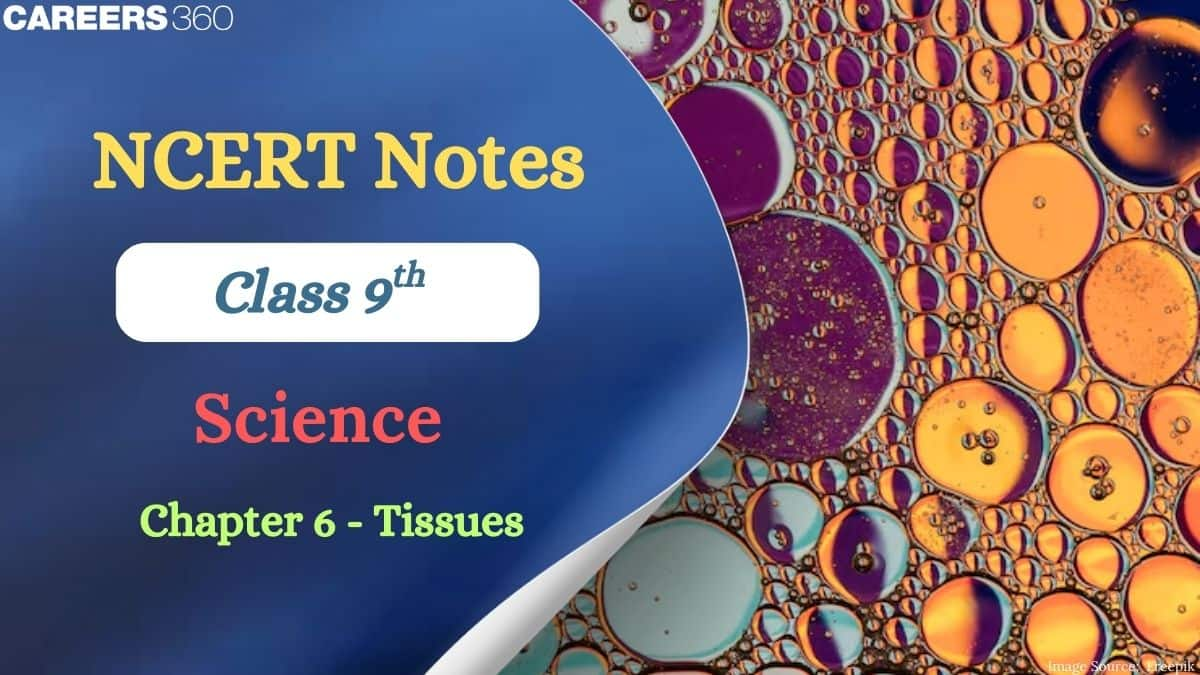
The Tissues Class 9 Notes cover topics such as plant tissues, like meristematic and permanent tissues, and in animals, like epithelial, connective, muscular, and nervous tissues. All the tissues are specialised for tasks such as protection, support, movement, and coordination. The notes offer easy explanations that help in building a strong foundation in the Science subject. By doing regular practice with the NCERT Notes for Class 9, students can improve their understanding and perform better in exams.
NCERT Class 9 Science Chapter 6 Tissues Notes: Download PDF
Tissues is an important chapter that builds the base for understanding the structure and function of organs. These PDF notes explain the chapter in a simple way with clear examples and key points. Students can download the PDF from the link given below and use the file both online and offline for quick revision. The NCERT Notes for Class 9 Science help in saving time while preparing for exams effectively.
Also, students can refer to:
Class 9 Science Chapter 6 Tissues Notes
Many students get confused between plant and animal tissues while studying. The tissues chapter explains the structure and function of different types of plant and animal tissues. It also helps students understand how cells group to perform specific tasks. These NCERT Class 9 Science Chapter 6 Notes help students clear all the concepts included in the NCERT with easy explanations.
What is a tissue?
- In unicellular organisms, one single cell performs all the basic functions.
- In multicellular organisms, where there are millions of cells, every cell is assigned one particular function to perform.
- As can be seen in human beings, muscle cells are responsible for contraction and relaxation, blood is responsible for the transportation of important materials, and nerve cells are important for transferring messages.
- The chapter explains how it can be concluded that in multicellular organisms, there is division of labour.
- A specific set of cells at one location within the body performs one specific function.
- A group of cells that are similar in structure work together to achieve a particular function and form a tissue.
Are Plants and Animals Made of the Same Types of Tissues?
- We can get to know whether plant tissues and animal tissues are the same by looking into their structures.
- As we know, plants are stationary; they don’t need to move and to stay upright, they also need supportive tissue that is mostly composed of dead cells,
- whereas when it comes to animals, they are always moving around in search of food, shelter, etc., and that’s why they require more energy as compared to plants because they contain living cells.
- When it comes to dividing, it can be seen that in plants, there are certain demarcated areas where growth takes place, and also that growth in plants can take place throughout their lifetime.
- Based on those growth phases, they can be divided into permanent and meristematic tissues as well.
- In animals, growth can take place only within a certain period.
- The growth and the basic difference in their functionality lie in the complexity of plants and animals, as it can be very well observed that animals have much more complex organisation as compared to plants.
Plant Tissues
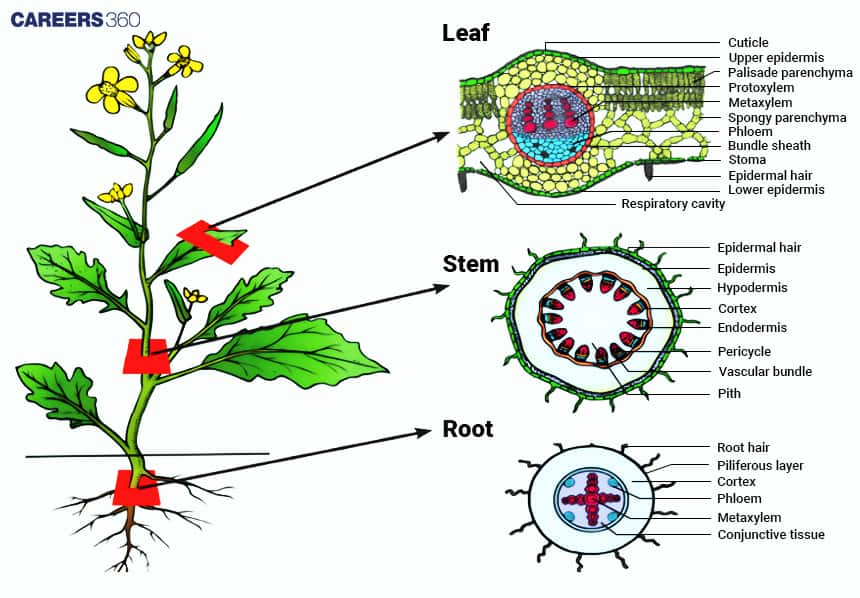
Meristematic Tissue:
- Meristematic Tissues are the tissues that have the capacity to divide. Initially, the cells that are formed after division look the same, but gradually, they occupy different structures according to their functions.
- Meristematic tissue is present at some particular, specific sites in plants; based on that, they can be primary meristematic or secondary meristematic.
- Primary meristematic tissue involves apical meristems, which are present at the root and shoot tips of the plant and are involved in increasing the length of the plant.
- Intercalary meristematic tissue is present in the form of patches at the nodes of the plant.
- Secondary meristematics, also known as lateral meristematics or cambium, is involved in increasing the girth of a plant. All the cells of the meristematic tissue have thin cell walls and dense cytoplasm.
Permanent Tissue:
After meristematic tissue loses its capacity to divide, it acquires a specific function and forms permanent tissue, and this process is known as differentiation.
- Permanent tissues can be further categorised as simple permanent tissues and complex permanent tissues, where simple permanent tissues are made up of all the same kinds of cells, whereas complex permanent tissues are made up of different kinds of cells.
Simple Permanent Tissue
- Under the simple tissue comes the parenchyma, which is present below the epidermis of a plant.
- These cells are living and isodiametric in shape, have thin cells, and are loosely arranged to fill the space.
- These have large intercellular spaces between them and provide the function of food storage.
- Sometimes, it contains chloroplasts and thus performs photosynthesis; it’s known as chlorenchyma.
- In aquatic plants, it consists of air spaces that help them to float, and it is known as aerenchyma.
- Another simple permanent tissue is collenchyma, which provides flexibility and mechanical support to plants.
- It helps the plants bend and present themselves in tendrils and climbers, as well as below the epidermis in leaf stalks.
- These are living cells below the epidermis with irregular thickening around them and comparatively fewer intracellular spaces between their cells.
- Sclerenchyma is also a simple, permanent tissue that provides strength to plants.
- It is present in the dead parts of the plant, as all the cells are dead.
Complex Permanent Tissue
- As you already know, complex tissues are made up of different kinds of cells. All these cells coordinate together to perform a common function.
- Complex permanent tissue can be further categorised into xylem and phloem, and both are conducting tissues constituting vascular bundles.
- Xylem tissue is made up of tracheids, vessels, xylem fibres, and xylem parenchyma.
- Tracheids and vessels are both tubular structures that are responsible for the transportation of water, whereas xylem parenchyma stores food, and xylem fibre provides support to plants.
- Phloem consists of sieve tubes, companion cells, phloem fibres, and phloem parenchyma.
- Except for phloem fibres, all are living cells, and all cells together help in the transportation of food from leaves to other parts of the plant. Sieve tubes have perforated structures known as sieve plates.
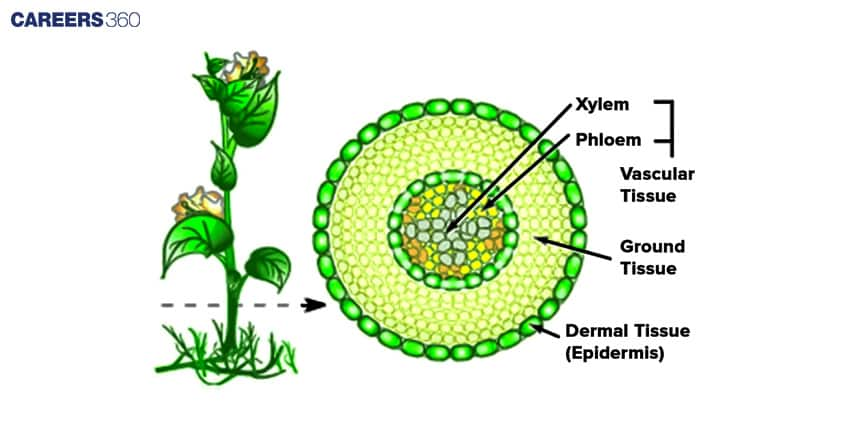
Animal Tissues
- If we take the example of the human body, when we breathe, we can feel the lungs being uplifted, which is done by the muscular tissue in our body.
- The oxygen that is collected in the lungs is transported to other parts of the body with the help of blood, which is also responsible for the transport of food and other nutrients from one part of the body to another, as well as the release of waste from the body.
Epithelial Tissue:
- This tissue forms the outermost protective layer of the body and also lines the internal and external parts of the organs.
- It acts as a separation between different organs in the body.
- Epithelial tissue works for the functions of protection, secretion, and absorption.
- Based on its structure and function, epithelial tissue can be classified as simple or compound.
- In compound epithelium tissue, multiple layers of epithelial cells are present.
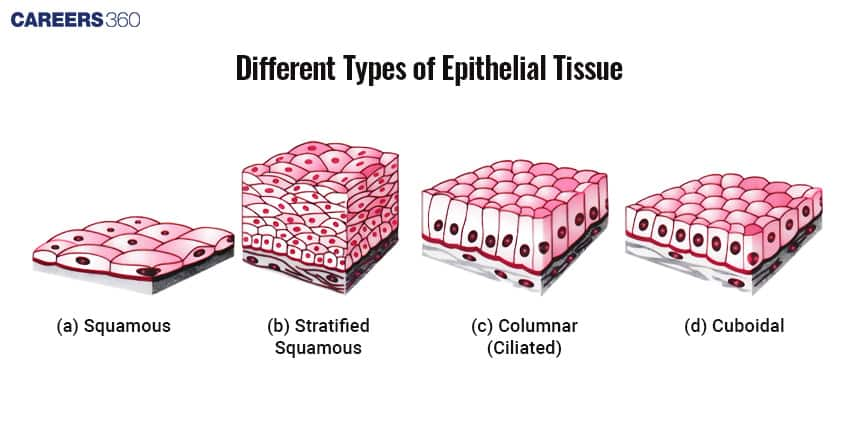
In the case of simple epithelial tissue:
A simple epithelial tissue that is present in the walls of blood vessels and the air sacs of the lungs is known as squamous epithelium. It forms a diffusion boundary as well.
A simple epithelial tissue that is present in the ducts of glands and the tubular parts of the nephron in the Kidneys is known as the cuboidal epithelium. The main function of the cuboidal epithelium is secretion and absorption.
The simple epithelial tissue that is present in the stomach lining and intestine lining is the columnar epithelium. Its main function is secretion and absorption.
A type of simple epithelial tissue is known as the ciliated epithelium, in which columnar or cuboidal cells bear cilia. They are present on the inner surface of hollow organs like bronchioles and fallopian tubes. It functions to move particles or mucus in a specific direction.
Simple epithelial tissue also includes glandular epithelium. When some of the columnar or cuboidal cells get specialised for secretion, it is known as the glandular epithelium. It is further categorised as exocrine and endocrine glands.
Connective Tissue:
- Connective tissues are the tissues that connect the body's organs. Cells of these tissues are loosely arranged in a matrix. The nature of the matrix depends upon the function of the tissue.
- Connective tissue can be categorised into three categories. They are loose connective tissue, dense connective tissue, and specialised connective tissue.
- Loose connective tissues consist of Areolar and Adipose tissues. Areolar makes the filling between the organs for protection, and adipose tissue stores fat (triglycerides). Glycogen is stored mainly in the liver and muscles.
- Ligaments and tendons come under dense connective tissue. Ligaments and tendons are both fibrous tissues. Ligaments are present between two bones, and tendons are present between muscles and bones. This can be remembered by BLB, where B stands for bones and L stands for ligaments. One ligament is present between two bones.
- Under specialised connective tissue, bones, cartilage, and blood are present.
- Bones are harder than cartilage because of the presence of a hard matrix that is made up of calcium. The major function of blood is the transportation of energy, gases, hormones, etc. 95 % of blood is plasma that contains RBCs. That is responsible for the transport of oxygen. It contains WBCs for increasing immunity and platelets for clotting purposes.
- Lymph is a part of the blood that contains fewer proteins and fewer RBCs, making it pale in colour. It is used to transport fats.
Muscular Tissue:
- Muscular tissue constitutes 40% of our body and can be classified as skeletal muscular tissue, smooth muscle tissue, and cardiac muscular tissue.
Skeletal muscles are cylindrical, unbranched, multinucleated, striated, and voluntary; that is, they are under our control and are found around the skeleton, for example, the biceps.
Smooth muscles are spindle-shaped, uninucleated, and involuntary; that is, they are not under our control and are striated. They are found in the intestinal organs.
Cardiac tissue is simple, as it is found only in the heart and is involuntary; it's uninucleated, branched, and striated.
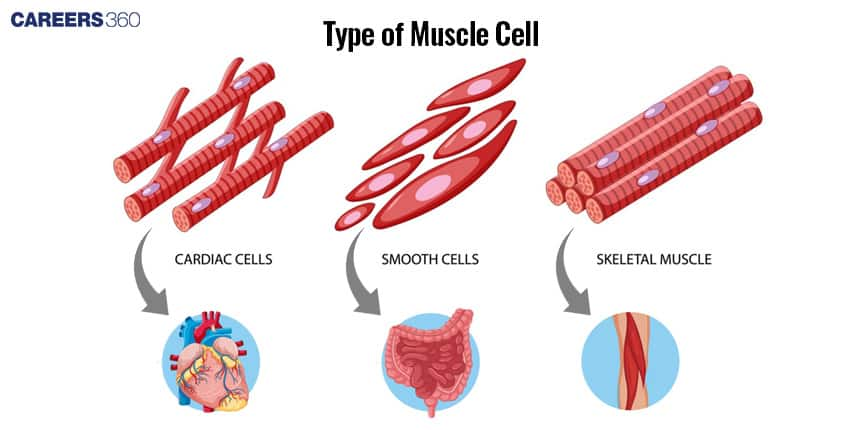
Nervous Tissue:
- The nervous system consists of long neural cells called neurons, which are responsible for transporting stimuli from one part of the body to another.
- A neuron is made up of a cell body (which contains a nucleus and cytoplasm), dendrites (long, thin, hair-like portions that emerge from the cell body), and an axon (a single long component).
- A nerve impulse is a signal that travels along a nerve fibre.
- Nerve impulses provide us with the ability to move our muscles when we wish to.
- Most animals rely on a functional combination of nerve and muscle tissue to function.
- This combination of Nervous Tissue and impulse allows animals to respond to stimuli quickly.
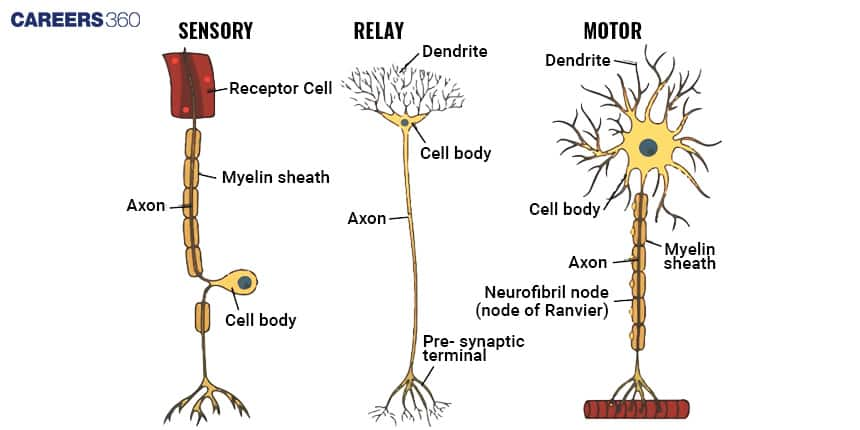
Also, Read
Chapter 6 Science Tissues: Previous Year Question and Answers
Given below are some of the previous year's questions from this chapter. These questions show the exam pattern clearly.
They also help students check how well they are prepared.
Question 1: Which two muscle fibers are cylindrical in shape?
Option 1. Cardiac muscle
Option 2. Cardiac and smooth muscle
Option 3. Smooth and skeletal muscle
Option 4. Cardiac and skeletal muscle
Answer:
Both cardiac and skeletal muscle fibers are cylindrical in shape, which allows them to contract efficiently along their length. Skeletal muscles are long, unbranched, and multinucleated, while cardiac muscles are branched and have a single nucleus. In contrast, smooth muscles are spindle-shaped, not cylindrical.
Hence, the correct answer is option (4), Cardiac and skeletal muscle
Question 2: Which of the following muscle cells are uninucleated?
Option 1. Cardiac muscle
Option 2. Cardiac and smooth muscle
Option 3. Skeletal muscle
Option 4. Smooth muscle
Answer:
Both cardiac and smooth muscle cells have only one nucleus, so they are called uninucleated. Skeletal muscle cells are different because they have many nuclei.
Hence, the correct answer is option (2), Cardiac and smooth muscle
Question 3: Which of the following connectives has the hardest intercellular matrix?
Option 1. Bone
Option 2. Cartilage
Option 3. Ligament
Option 4. Tendon
Answer:
Bone has the hardest intercellular matrix because it contains calcium and phosphorus salts. This makes bones strong and rigid, unlike other connective tissues.
Hence, the correct answer is option (1), Bone
Subject-Wise NCERT Solutions
How to Use Tissues Class 9 Notes Effectively?
Tissues form the basic framework of plants and animals, and studying them makes it easier to understand how different parts of the body work together.
Start with Class 9 Science Chapter 6 Tissues Notes PDF to get a clear overview of plant and animal tissues.
Pay special attention to diagrams of permanent and meristematic tissues, as they are frequently asked in exams.
Compare the functions of different tissues in plants and animals to understand how they support life processes.
Use flowcharts or tables to remember the classification of tissues easily.
Revise regularly with Class 9 Science Chapter 6 Tissues Notes to strengthen the concepts of tissues and improve retention.
Advantages of Class 9 Science Chapter 6 Tissues Notes
Studying through the well-organised notes helps students clearly understand how cells are organised and group together to form tissues, which perform specific functions.
- Class 9 Science Chapter 6 Tissues Notes PDF helps in doing quick revision before exams and saves a lot of time.
- Different types of tissues, their structure, and functions are explained, along with examples.
- The notes strengthen conceptual knowledge, which builds the base for higher classes, and mainly for the subject of biology.
- Students who regularly revise their notes will improve their visual memory, as diagrams are included.
Chapter-Wise NCERT Class 9 Notes Science
Below are the links to detailed notes for each chapter, designed to help students quickly revise and understand important concepts. These notes make learning easier by presenting topics in a clear and well-structured way.
Frequently Asked Questions (FAQs)
Following are the differences:
Simple Permanent Tissue | Complex Permanent Tissue |
|
|
| 2. Composed of several types of cells |
| 3. There are two: xylem and phloem |
(a) that forms the inner lining of our mouth - Squamous Epithelium
(b) that connects muscle to bone in humans - Tendons
(c) that transports food in plants - Phloem
(d) that stores fat in our bodies - Adipose
(e) tissue with a fluid matrix - Blood
The differences are as follows:
Parenchyma | Collenchyma | Sclerenchyma |
Cells are loosely packed | Cells are tightly packed | Cells are tightly packed |
Living cells | Living cells | Non-living cells |
found in almost all tissues | provide flexibility | Provide thickness |
The cell wall is made up of cellulose | The cell wall is made up of pectin | The cell wall is made up of lignin |
Thin cell wall | thicker cell wall | thickest cell wall |
The epidermis plays a very important role in plants. It acts as a barrier between the plant and the outside environment. As given in the NCERT Class 9 Science Chapter 6 Notes Tissues, it also depends on the plant to prevent water loss and regulate gas exchange. The epidermis also secretes various metabolic chemicals and helps in the absorption of water and mineral nutrients in the roots.
Skeletal Muscle | Smooth Muscle | Cardiac Muscle |
|
|
|
2. Voluntary | 2. Involuntary | 2. Involuntary |
3. cylindrical, multinucleated, and striated | 3. spindle, uninucleate and unstriated | 3. cylindrical, uninucleate, and striated. |
The notes cover different types of plant tissues such as meristematic and permanent tissues, and animal tissues including epithelial, connective, muscular, and nervous tissues.
These notes summarize definitions, differences, and functions of various tissues in a simple format, along with diagrams, making revision quicker and improving answer presentation in exams.
Courses After 12th
Applications for Admissions are open.
As per latest syllabus. Physics formulas, equations, & laws of class 11 & 12th chapters
JEE Main Important Chemistry formulas
Get nowAs per latest syllabus. Chemistry formulas, equations, & laws of class 11 & 12th chapters
JEE Main high scoring chapters and topics
Get nowAs per latest 2024 syllabus. Study 40% syllabus and score upto 100% marks in JEE
JEE Main Important Mathematics Formulas
Get nowAs per latest syllabus. Maths formulas, equations, & theorems of class 11 & 12th chapters
